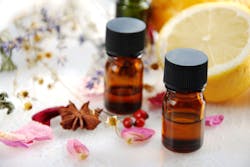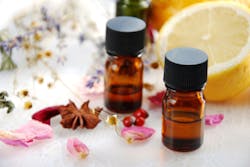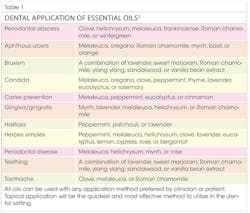Incorporating Essential Oils into Clinical Dentistry
BY Mackenzie Crowe, RDH, BS, Courtney Harness, RDH, BS, Kayla Hertel, RDH, BS, and Emily Holt, RDH, MHA, CDA, EFDA
When dental hygienists hear the words "essential oils," over-the-counter antimicrobial mouthrinses might come to mind. However, essential oils have a much broader application in both dentistry and medicine. Although they are the oldest form of medicine known to humankind, until recently their therapeutic uses were still unknown to a vast majority of people.1 Many studies have demonstrated the therapeutic effectiveness of essential oils, but few have incorporated their use in clinical dentistry.
Essential oils are a subcategory of holistic therapy, which is a form of healing that considers the person as a whole-mind, body, spirit, and emotions-in search for optimal health and wellness.1 A healthy oral cavity can be enhanced through use of essential oils. Essential oils are volatile liquids that are distilled from plants.2 The liquid comes from respective parts of the plant (i.e., seeds, bark, leaves, stems, roots, flowers, fruits) and these oils are used to manage and potentially eliminate health conditions within the body. It is necessary to obtain certified pure therapeutic-grade essential oils, no matter how costly, to ensure positive therapeutic outcomes.2 Anything less than certified pure oils may not produce the desired results and could possibly produce aromatic effects only, or even be extremely toxic.2 One of the factors that determines the purity and therapeutic value of an oil is its chemical constituents.2 These can be affected by a vast number of variables (e.g., soil condition, fertilizer (organic or chemical), geographic region, climate, altitude, harvest season and method, distillation process).2 There are no substitutes for pure oils. Pure essential oils cannot successfully be recreated in a laboratory.2
It may take several hundred or thousand pounds of plant material to make one pound of pure essential oil.2 This causes a large increase in the price of the oils. The vast majority of oils produced today are used in the perfume industry; therefore, they are only purchased for their aromatic qualities. These oils go through a much more intense distillation process and, although they may smell as good and cost much less, they will lack most, if not all, the chemical constituents necessary to produce therapeutic results.2
Their small molecular size allows penetration of the skin much quicker than over-the-counter medications.2 They are also lipid-soluble and can penetrate cell membranes, reaching every cell of the body within 20 minutes.2 These oils contain oxygen molecules that help transport nutrients to the starving cells, which stimulates the immune system and helps reverse a nutritional deficiency.2 Most often these oils are so potent that they must be diluted before they can be applied, but this does not alter the therapeutic result.2 This involves mixing the essential oil with a less potent liquid (e.g., fractionated vegetable or coconut oil).
Essential oils can be applied in many different ways. The first method is topical application-in other words, placing essential oils on the skin, hair, mouth, teeth, nails, or mucous membranes of the body.2 This includes direct application, massage, warm compresses, and adding the oils to bathwater. One form of topical application is the practice of oil pulling; oils are swished in the mouth for 5-20 minutes. If essential oils are incorporated in oil-pulling techniques, they are added to another oil, such as coconut or olive oil.
The next method of application is aromatic, in which either a fine mist of the oil or a vapor of volatile aromatic components that have been evaporated from the oil is inhaled.2 Aromatherapy affects memory, hormones, and emotions through the olfactory system.2 Essential oils can be used in the aromatic form through diffusion, direct inhalation, hot water vapor, fans, vents, or humidifiers, and perfumes or cologne. The final method of application is internal; consuming or otherwise internalizing the oil into the body.2 Internal application of an essential oil includes placing oils under the tongue, adding oils to beverages or foods while cooking, and placing oils in capsules to ingest. It is important to recognize that only pure oils should be used for internal consumption. The US Food and Drug Administration labels some essential oils as GRAS, meaning generally recognized as safe for human consumption.2
There are many benefits to using essential oils. They contain the same regenerating, oxygenating, and immune-strengthening characteristics of the plants from which they are extracted.2 Essential oils are powerful antioxidants which help to eliminate free radicals and prevent mutations, fungus, and oxidation in the cells.2 Essential oils contain both antimicrobial and antibacterial properties. The overuse of antibiotics has caused microorganisms to develop resistance to antibiotics.3 Microorganisms, however, do not appear to develop tolerance or resistance to the antibacterial effects of essential oils, and essential oils' antimicrobial power does not diminish over time.3 Essential oils are found in over-the-counter mouthrinses. The combination of essential-oil mouthrinse and subgingival ultrasonic instrumentation has shown improved subgingival bacterial count reduction in both shallow and deep pockets when tested on chronic periodontitis patients.4
There are many more ways to use essential oils that would benefit the dental office. Studies have shown that lavender oils have been proven to alter emotional states and mild anxiety, as well as provide pain reduction upon needle insertion.5 Use of aromatherapy with orange oils has been shown to reduce salivary cortisol and pulse rate in children with anxiety.5 Treatment of dental-implant-material surfaces with cinnamon and clove oils has shown to inhibit biofilm production.5 Clove oil has been used in dentistry for many years and has proven to be of great use as an antibacterial and antifungal. Clove oil is used to treat dry socket, tooth pain, and candidiasis.6 Eucalyptus oil is used in products as sealers and solvents for root canal fillings and also has antimicrobial properties.6 A study performed to test the antimicrobial efficacy of different oils demonstrated that peppermint, tea tree, and thyme oils can act as intracanal antiseptic solutions against oral pathogens.7
Numerous medical and dental conditions can be treated with essential oils (see Table 1). Particular essential oils can be used to treat a large variety of conditions and therefore would be best suited to be kept in the dental office. These include melaleuca, helichrysum, Roman chamomile, clove, and lavender.
• Melaleuca is commonly known as tea tree oil. It comes from a plant in Australia that resembles a shrub.8 Its properties were discovered by Aborigines who would chew on the leaves and brew them as a tea.8 Melaleuca is commonly known as an antiseptic and an antifungal agent. Terpenoid and cineole are believed to be the chemical compounds in melaleuca oil that make it clinically effective. Terpenoid contributes to its healing properties and cineole facilitates disinfection of surfaces where it is applied.8 A study conducted on German chamomile and melaleuca found that melaleuca was more effective at removing the smear layer and was a better choice for disinfection for root canals with less possibility of toxicity.9 In September 2014, the Manipal College of Dental Sciences researched the antifungal activity of melaleuca compared to fluconazole (Diflucan), a common drug prescribed for treatment of candidiasis. Their research concluded that both substances showed comparable antifungal activity at 24 hours against candida albicans.10 By day seven, fluconazole had completely lost its antifungal properties, whereas melaleuca oil had substantially sustained its antifungal action.10
• Clove is a bud from an evergreen tree.11 It was primarily used in ancient Indian and Chinese civilizations before its popularity spread to Western civilizations.11 Clove oil is rich in minerals, such as calcium, hydrochloric acid, iron, phosphorus, sodium, potassium, and vitamins A and C.11 Its main chemical compound is eugenol, which is full of antioxidants and insecticidal components.12 Clove can be used as a topical application to relieve pain and promote healing.12 Kuwait University researchers completed a study that examined whether clove oil could replace benzocaine as a topical anesthetic.13 They concluded that clove oil can be used in place of benzocaine topical.13 The use of clove oil as a topical anesthetic agent instead of benzocaine will reduce the dose of drugs the patient absorbs and is a less expensive alternative.13
• Lavender oil is extracted from the lavender plant through steam distillation.14 The active ingredients in lavender oil are terpenes and sesquiterpines.15 Lavender oil provides psychological and physiological benefits when used correctly.14 Although most consider lavender to be mainly used in aromatherapy, it also has anti-inflammatory and antimicrobial components.14 Lavender is known for its relaxing, carminative, and sedative effects and its ability to eliminate nervous tension.16 Researchers from London's King's College determined that lavender aromatherapy used in dental offices reduces anxiety levels in patients.17
As dental practitioners acquire a better understanding of essential oils, they might be more likely to adopt holistic approaches to oral care. Holistic medical practices are helping patients make lifestyle changes (diet, nutrition, stress reduction, exercise, for example) coupled with newer, alternative ways of treatment. The dental office should be no different. Essential oils can provide multiple options and allow the practice to expand services for patients, offering a more natural way of relieving oral conditions. RDH
Mackenzie Crowe, RDH, BS, Courtney Harness, RDH, BS, and Kayla Hertel, RDH, BS, recently graduated from the University of Southern Indiana with a Bachelor of Science in Dental Hygiene in May 2015. Emily Holt, RDH, MHA, CDA, is a clinical associate professor of dental hygiene at the University of Southern Indiana. She can be reached at [email protected]
References
1. Holistic Medicine. American Cancer Society. http://www.cancer.org/treatment/treatmentsandsideeffects/complementaryandalternativemedicine/mindbodyandspirit/holistic-medicine. Updated January 16, 2013. Accessed March 17, 2015.
2. Modern Essentials: A Contemporary Guide to the Therapeutic Use of Essential Oils. 5th ed. Orem, Utah: AromaTools; 2014.
3. Schechter B. Time-tested botanical remedies for modern periodontal therapy. Dent Today. 1998;17:110-115.
4. Morozumi T, Kubota T, Abe D, Shimizu T, Nohno K, Yoshie H. Microbiological effect of essential oils in combination with subgingival ultrasonic instrumentation and mouth rinsing in chronic periodontitis patients. Int J Dent. 2013;146479. doi: 10.1155/2013/146479.
5. Dagli N, Dagli R. Possible use of essential oils in dentistry. J Int Oral Health. 2014;6: i-ii.
6. Agarwal R, Lakshmi T. Essential oils in dentistry-An update. Int J PharmTech Research. 2013;5:1804-1807.
7. Thosar N, Basak S, Bahadure RN, Rajurkar M. Antimicrobial efficacy of five essential oils against oral pathogens: An in vitro study. Eur J Dent. 2013;7(Suppl 1):S71-7.
8. Tea tree oil - just a fad? RDH. August 2006;26(8). http://www.rdhmag.com/articles/print/volume-26/issue-8/columns/mind-body-spirit/tea-tree-oil-just-a-fad.html. Published August 2006. Accessed March 17, 2015.
9. Pujar M, Makandar S. Herbal Usage in Endodontics- A review. Int J Contemp Dent. 2001;2:34-37.
10. Sharma S, Hedge V. Comparative evaluation of antifungal activity of melaleuca oil and fluconazole when incorporated in tissue conditioner: an in vitro study. J Prosthodont. 2014;23:367-373. doi: 10.1111/jopr.12117.
11. Health Benefits of Clove Oil. Organic Facts. https://www.organicfacts.net/health-benefits/essential-oils/health-benefits-of-clove-oil.html. Accessed March 17, 2015.
12. Chaieb K, Hajlaoui H, Zmantar T, et al. The chemical composition and biological activity of clove essential oil, Eugenia caryophyllata (Syzigium aromaticum L. Myrtaceae): a short review. Phytother Res. 2007;21:501-6.
13. Alqareer A, Alyahya A, Andersson L. The effect of clove and benzocaine versus placebo as topical anesthetics. J Dent. 2006;34:747-50. doi: http://dx.doi.org/10.1016/j.jdent.2006.01.009.
14. Cavanagh HM, Wilkinson JM. Lavender essential oil: a review. Aus Inf Control. 2005;10:35-37.
15. Cavanagh HM, Wilkinson JM. Biological activities of lavender essential oil. Phytother Res. 2002;16:301-308.
16. Zabirunnisa M, Gadagi JS, Gadde P, Myla N, Koneru J, Thatimatla C. Dental patient anxiety: Possible deal with Lavender fragrance. J Res Pharm Pract. 2014;3:100-103. doi:10.4103/2279-042X.141116.
17. How the scent of lavender can ease those fears about going to a dentist. Daily Mail. http://www.dailymail.co.uk/health/article-1054827/How-scent-lavender-ease-fears-going-dentist.html. Updated September 11, 2008. Accessed July 24, 2015.



